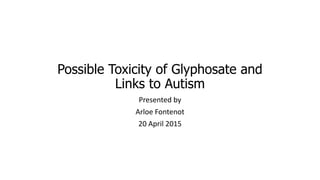
Possible Toxicity of Glyphosate and Links to Autism
- 1. Possible Toxicity of Glyphosate and Links to Autism Presented by Arloe Fontenot 20 April 2015
- 2. “Half of all children will be autistic by 2025, warns Senior Research Scientist at MIT…” • Stephanie Seneff, PhD, has concentrated her research on the relationship between nutrition and health • Published over 170 peer-reviewed articles focusing on Alzheimer’s, autism, cardiovascular disease, as well as impacts of nutritional deficiencies and environmental toxins on human health • Has shown a correlation between use of Roundup herbicide and rising rates of autism • Glyphosate is a known inhibitor of the Shikimate pathway
- 3. Primary active ingredient in Monsanto Co. Roundup herbicide Not a typical organophosphate but an aminophoshonic analog of glycine, and does not inhibit cholinesterase activity Found in over 750 commercial products sold in the United States Shikimate pathway – occurs only in microorganisms and plant cells Pathway goals: Biosynthesis of 3 aromatic amino acids: tryptophan, phenylalanine, and tyrosine from phosphenol pyruvate (PEP) and erythrose 4-phosphate (E4P) Tryptophan and phenylalanine are both essential aa’s, where phenylalanine is converted to tyrosine (non-essential). Tyrosine is converted to L-Dopa, the precursor for monoamine neurotransmitters dopamine, noradrenaline, and adrenaline Shikimate Pathway has been referred to as the common aromatic biosynthetic pathway Glyphosate’s target enzyme is 5-enolpyruvylshikimate 3-phosphate (EPSP) synthase, the sixth enzyme of the pathway Glyphosate occupies the binding site of PEP on the enzyme prohibiting formation of chorismate Scientists target this enzyme for many herbicides, and antibiotic and antipathogenic drugs (Schonbrunn, Kabsch et al, 2000) Courtesy cell.com
- 4. Shikimate Pathway (plants and bacteria) • Two parts, from PEP and E4P to chorismate, which is common to all 3 aromatic amino acids, and from chorismate to each individual aromatic amino acid • Seven Common Steps • Step 1 – Glycolytic intermediate PEP and pentose phosphate pathway intermediate E4P are condensed to a seven- carbon six-membered heterocyclic compound, 3-deoxy-D-arabino-heptulosonate 7-phosphate (DAHP) • Step 2 – Exocyclic C7 on DAHP is substituted for a ringed oxygen to form a highly substituted cyclohexane derivative, 3-dehydroquinate • Step 3-Step 7 –The five remaining steps introduce a side chain and two of the three double bonds converting the cyclohexane from step 2 into the benzene ring • Step 6 (PEP to EPSP) is catalyzed by EPSP synthase, the best studied enzyme of the pathway. The target for glyphosate herbicide in plants, but inhibits the pathway in microbes also. Plant enzymes have glyphosate K1 values approx. one order of magnitude lower than microbial enzymes. The high degree of specificity of glyphosate for EPSP synthase is due to the herbicide binding to the enzyme only in close proximity to shikimate 3-phosphate formed in step 5, coupled with the product of the enzyme catalyzed reaction, EPSP in step 6, also facilitating glyphosate binding • Step 7 – involves 1,4-trans elimination of phosphate from EPSP to form chorismate • Chorismate is the substrate for Tryptophan, Phenylalanine, and Tyrosine, however when EPSP is inhibited by glyphosate, chorismate is prohibited from being formed
- 5. How can a chemical that affects plants and bacteria induce toxicity in humans? • When humans ingest small amounts of glyphosate through pesticide residues in food, the Shikimate pathway is inhibited in human gut bacteria • The seven steps of the Shikimate pathway are identical in bacteria, so exposure to glyphosate targets EPSP in intestinal bacterial • Decrease in synthesis of aromatic amino acids phenylalanine, tryptophan, and tyrosine causing translational deficits • Aromatic amino acid repression causes decreases in signaling molecules dopamine, norepinephrine, and epinephrine, and skin pigment melanin • Human body contains around 100 trillion flora in the intestines • Gut or intestinal flora are also responsible for metabolizing undigested carbohydrates, allowing for human reabsorption of short-chain fatty acids. Also play a role in synthesizing vitamins B and K. Food allergies such as gluten intolerance and disrupted sulfur metabolism leading to sulfur and sulfate deficiency • Systemic toxicity caused by disruption of microbial functioning allows for overgrowth of pathogens in the body • New research is showing glyphosate synergistically causing toxicity by inhibition of human CYP 450 enzymes coupled with the disruption of aromatic amino acid synthesis, as well as impaired serum sulfate transport • This evidence is pointing to glyphosate enhancing damaging effects of other food-borne chemical residues and other environmental toxins (eg. formaldehyde) by shutting down detoxifying enzymes (CYP) • Formation of ammonia from microbial breakdown of glyphosate in the human body can lead to brain inflammation associated with autism and Alzheimer’s disease
- 6. Links to Autism • Imbalance in gut flora causes the same type of gastrointestinal disturbances witnessed in autism spectrum disorder • Although not a direct linkage has been established, it is possible aromatic amino acid biosynthetic repression by increased usage of glyphosate-based products may be responsible for the intellectual disability, difficulties in motor coordination, and physical health issues such as sleep disturbances and food intolerances leading to autism Question How does glyphosate indirectly cause symptoms of Autism spectrum disorder?
- 7. References Alliance for Natural Health USA. (2014). Half of All Children Will Be Autistic by 2025, Warns Senior Research Scientist at MIT. Retrieved from http://www.anh-usa.org/half-of-all-children-will-be-autistic-by-2025-warns-senior-research-scientist-at-mit/ Herrmann, Klaus M. (1995). The Shikimate Pathway: Early Steps in the Biosynthesis of Aromatic Compounds .The Plant Cell. Vol 7., 907-919. Retrieved from http://www.plantcell.org/content/7/7/907.full.pdf Mercola, Dr. Joseph. 09 June 2013. Monsanto’s Roundup Herbicide May Be Most Important Factor in Development of Autism and Other Chronic Disease. Retrieved from http://articles.mercola.com/sites/articles/archive/2013/06/09/monsanto- roundup-herbicide.aspx Autism Speaks. What is Autism?. Retrieved from https://www.autismspeaks.org/what-autism